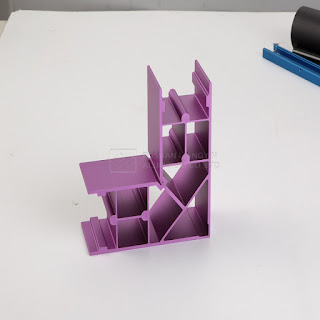Advantages of Aluminium
Aluminium is an extremely versatile metal with a number of advantages, it is recognised for being both lightweight and flexible. It can be cast, melted, formed, machined and extruded meaning that it can be manufactured into a variety of shapes and then subsequently fabricated to suit a whole variety of uses. Due to its extreme versatility and strength, the use of Aluminium is becoming more popular, especially with the advantages it has to offer. Through the process of aluminium extrusion it can be supplied in ever more complex designs. This extrusion can be supplied in a variety of finishes including anodised, mill or painted and can then be further machined or fabricated.
Light Weight
A known lightweight metal, it has a specific weight of approximately 2.71 g/cm3. It’s about a third of the weight of steel, which makes it easier and cheaper to transport than most other metals. The strength of aluminium can be adapted using varying alloying elements to provide better benefits including higher strength or easier formability. Because of its lightweight nature, corrosion resistance and ease of fabrication, aluminium sheets are the firm for projects like vehicle panelling, artwork, building cladding and kitchen fitting among other applications.
Corrosion Resistance
Aluminium is a corrosion resistant metal that naturally generates a protective coating. The coating formed is extremely thin and is generated when aluminium comes into contact with an oxidising environment. This protective aluminium oxide layer helps protect the surface of the metal from corrosion. Additionally, getting surface treatment such as painting or anodising can further improve the overall corrosion resistance of the metal.
Electrical and Thermal Conductivity
It is an excellent conductor of heat and electricity. Although aluminium is not as conductive as copper it is approximately a third of the weight meaning that an aluminium wire with half the weight of a copper wire would have the same amount of electrical resistance. As a result, it is the chosen material for power transmission lines. It is also an excellent conductor of heat and is used as heatsinks in a variety of applications such as LED lights, electrical products, computer motherboards, etc.
Reflectivity and Ductility
Another benefit of Aluminium is that it serves as a good reflector. It is used in rescue blankets and light fittings because of its ability to reflect both light and heat.
Odourless and Impermeable
Even with 0.007 mm thickness of aluminium foil, it is still impermeable and doesn’t have a substance taste or smell. This is non-toxic and often used for packaging of the sensitive products including pharmaceuticals and food.
Recyclability
Contrary to what most people think, aluminium is a 100% recyclable and during the recycling process, it retains all of its original properties. During production, it is more cost-effective to use recycled metal than prime metal out of the ground and so, during production, as much recycled material is used as possible.

评论
发表评论